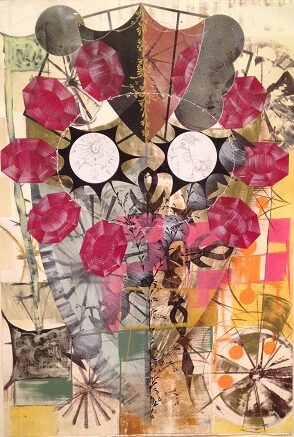
Lari Pittman
American, 1952-
Where Valor Will Produce the More Complex Bloom (6823 AD), 1987
acrylic, printer's ink, and enamel on paper
45 × 30 in.
SBMA, Gift of Gerald Ayres
2013.52

photo by Ranier Hosch, artillerymag.com
COMMENTS
The daily labors farmers and gardeners undertake to ensure bountiful harvests, year in and year out, rhyme with the way Pittman works — and the way his art looks. This is especially clear in “Orangerie,” the exhibition dedicated to the 58-year-old painter’s works on paper from 1980-2010.
It’s an awesome, jaw-dropping survey that includes approximately 120 images, some in books (designed by Jonathan Hammer and written by Dennis Cooper) but most hung floor-to-ceiling on all the walls, which have been painted by Norm Laich in a trellis pattern.
Pittman’s drawings hang from the 2-D trellis like ripe fruits and rare flowers. They are not hung in chronological order. Instead, they’re arranged aesthetically, their palettes, shapes and subjects forming complex dramas.
Initially, the installation is overwhelming. But it’s too sexy to shy away from.
Heightened attentiveness makes discriminating differences exciting. Not much is required to be able to pick out the comparatively crude drawings from the early ’80s, their awkward innocence and tentative bravery sweetly endearing, even corny, in relation to the ferocious elegance and operatic sophistication to come.
Lumpen figures appear in “Egg Sac” (1982), “Angstgefuhl (Feelings of Fear)” (1981) and “The Monarch” (1984). Abstract clusters of organic matter have plenty of room to grow in “Checks and Balances” (1982), “Territorial Rights” (1984) and several untitled monoprints from 1981-84. And the strange bird portrayed in the nearly 7-foot-long “Traveling Alone” (1982) is part roadrunner, part chicken, part woodpecker and all Pittman — a misfit convinced that it makes more sense for society to adapt itself to his vision than for him to fit into its conventions.
In the mid-’80s, the density and detail of Pittman’s abstract imagery intensifies exponentially. In “Farming the Self” (1986), illegible language fragments sprout from loamy fields. In “Tending the Farm” (1986), these loopy forms become pods and bottles. They get bigger and bolder and more whimsically Surreal in two works from 1987, “Where Curiosity and Diversity Will Grow Like Weeds (2737 A.D.)” and “Where Valor Will Produce the More Complex Bloom (6823 A.D.)”
In the '90s, Pittman’s pictures get more graphic and dynamic. Victorian silhouettes, stylized owls, disembodied eyeballs and all manner of decanters, beakers, vessels and vases draw viewers into tumultuous mixtures of color, texture and shape, as well as mood, atmosphere and sentiment.
Over the last decade, Pittman has continued to polish his skills as a colorist, creating indescribably vibrant combinations of weird tertiary tints that dazzle the eye and blow the mind. Compositional complexity, designer virtuosity, narrative ambiguity and sheer, visual genius pack his 16 works on paper from 2010 with more mesmerizing energy than anything else in “Orangerie.”
- David Pagel, Art Review: Lari Pittman at Regen Projects and Regen Projects II, Los Angeles Times, September 23, 2010
http://latimesblogs.latimes.com/culturemonster/2010/09/art-review-lari-pittman-at-regen-projects-and-regen-projects-ii.html
SBMA CURATORIAL LABELS
Los Angeles-based artist Lari Pittman is best known for his collage-like paintings that integrate elements of the decorative arts, Surrealism, folk art, and commercial advertisement. In meticulously-layered works, Pittman mines iconographic symbols to create colorful arrangements that are simultaneously nostalgic and futuristic. In "Where Valor Will Produce the More Complex Bloom (6823 AD)", Pittman creates a densely layered composition filled with shapes alluding to military insignia, mechanical processes, cut-jewels, and Victorian ornamentation that together create the effect of an armored shield.
- Ridley-Tree Rotation, 2018
Lari Pittman is inspired by commercial advertising, folk art, and decorative traditions, meticulously layering his lexicon of imagery into opulent scenes that are as visually compelling as they are psychologically complex. His work makes reference to a multitude of different sources, such as social realist murals, Mexican "retablos," Victorian silhouettes, and mid-century graphics, to name a few. The artist continues these visual references in highly dynamic compositions that verge on possible overload - appearing as if barely contained by their two-dimensional surfaces. Underlying each are possible narratives with themes of life, death, and love in a highly personalized and defiantly non-traditional manner.
"Where Valor Will Produce the More Complex Bloom (6823 AD)" rises from the artist's galleon-ship series, which commonly contains images of ships, gemstones, bleeding hearts, and a lacy bird (with or without and egg). Each of these icons has the potential to exist as a stand-in for the artist. Prominently in this drawing is a shield resembling the head of a figure surrounded by a ring of ruby-like jewels. The entire scene is set in motion by gray and black circular shapes, forming a spinning series of mechanized gears and chains. Suggested by the title, it appears as if the artist has created a force - valor - that generates an energy unto its own.
- Colefax Gallery, 2014
